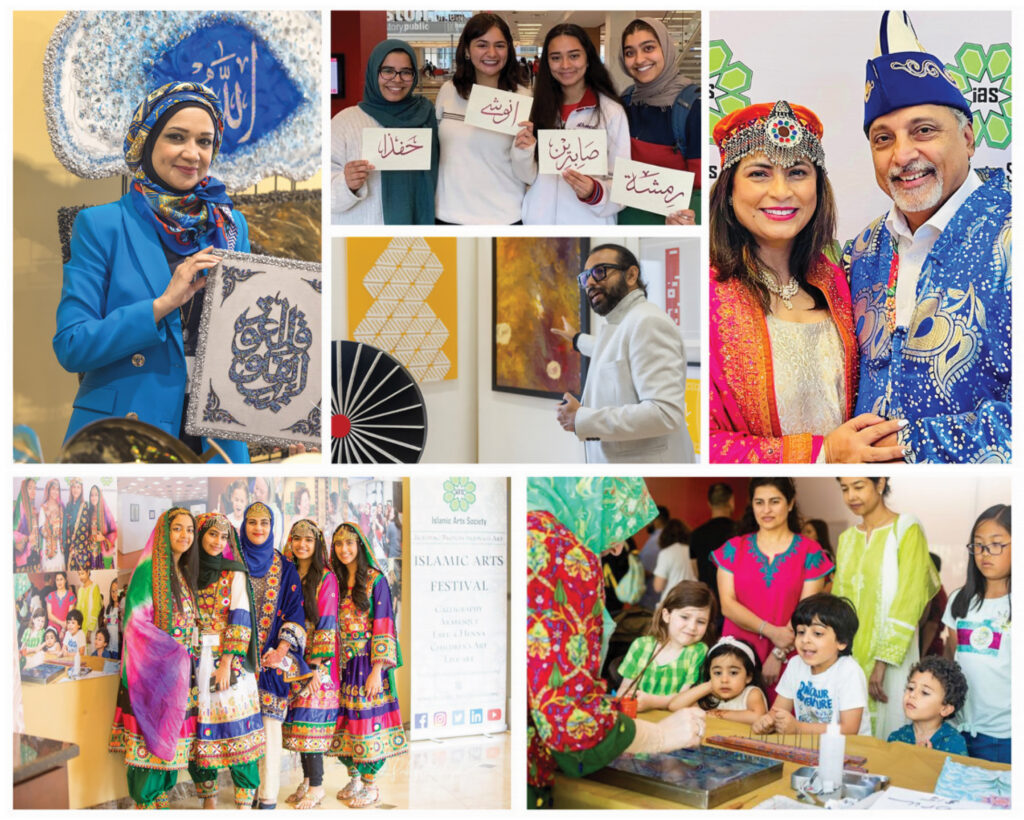Connecting the Divine with Communities
By Andrea Salamanca
Sept/Oct 2023

Art, perhaps the most abstract phenomenon in the hands of human beings, is boundless, revolutionary, fluid, and seeps into the lives of individuals worldwide. Islamic art does this and much more, for it transcends religion, language, time, and place to establish a connection between humans and the Divine. Drawing from sources such as Greek, Roman, and Byzantine art, Islamic art has found its way to the U.S., where it is ubiquitous and thriving.
We start this journey in the incredibly beautiful and diverse city of Houston, Texas. A cultural hub like few others in the country, Houston is the proud home of the Islamic Arts Society (IAS), an organization whose mission is to share this rich heritage. The society highlights how the patterns and designs that Americans come across within their daily lives are often rooted in Islamic art created centuries ago, thereby focusing on commonalities rather than differences. In doing so, the IAS hopes to break down cultural barriers and unite communities that would otherwise remain isolated.
As a student enrolled at the University of Houston’s World Cultures and Literature department, I had the opportunity to work with Mrs. Shaheen Rahman (president, IAS) and experience just how passionate she and her team are about making people aware of the society’s mission and providing resources for artists and communities alike.
In an individualistic society such as the U.S., it’s essential to not forgo the value of culture and tradition. I believe the IAS is working tirelessly to make sure that this does not occur. By organizing the county’s largest annual Islamic arts festival, the society has created a cultural impact unlike any other. Drawing more than 6,000 visitors from different backgrounds, this celebration is only one of the many ways in which IAS impacts the community. The society also hosts events in museums, libraries, art galleries and college campuses, thereby offering the public multiple opportunities for the public to learn more about this art’s rich heritage.
This rich tradition includes calligraphy, architecture, painting, ceramics, geometry, and many other forms. The tradition of Islamic arts is a way of life, a form of language, one used by artists to connect with their spirituality and share their culture. For these reasons, artists in the U.S. have prioritized it to help combat misconceptions and ignorance about Islamic culture.
Dr. Essamedin Alhadi (director, Education and Curatorial Affairs, the International Museum of Muslim Cultures) shares how difficult it has been to attract audiences, pointing to the museum’s location as well as the surrounding population’s perspective on the world of Islam as possible contributing factors. Even so, she and the museum are working hard to educate the public on the extensive world of Islamic art and how it has influenced other cultures, all while finding much value in sharing this history.
Other notable museums Islamic art collections include The Metropolitan Museum of Art (New York City), which holds 15,000+ objects in its Islamic arts gallery; the Los Angeles County Museum of Art, which notably features works of present-day Muslim artists; and the Smithsonian National Museum of Asian Art – where the Freer and Sackler galleries hold some of the most important Islamic illuminated manuscripts. The Museum of Fine Arts, Houston, displays its own Art of the Islamic Worlds collection, which recently expanded to six permanent galleries. The expansion brought hundreds of objects spanning more than 1,000 years of Islamic culture into the heart of Houston.
To gain a better understanding of the experiences of Muslim artists in the U.S., I had the pleasure of speaking with several renowned artists, including Dr. Nihad Dukhan, an Arab-American artist who holds a Ph.D. in mechanical engineering and is a traditionally trained calligrapher. Focusing on modern and traditional calligraphy, he hopes to bring awareness of the culture and connect with the American community. He believes that the public at large can relate to the themes often found in his work, which will help fight misconceptions about Islamic culture.
Adding on to this same idea, Ms. Elinor Holland, a distinguished calligrapher in the U.S., likes to choose Quranic phrases emphasizing social justice to spark conversations on the harmful rhetoric that has become embedded in many people’s mind.
To spread the message of the Divine, these artists have spent many years pouring their hearts into the subject. While creating what they consider sacred art, they seek to honor their religion, not themselves. They view their pieces as channels through which a connection with the Divine can be achieved. Artists such as Behnaz Karjoo, an illumination artist, and Zinnur Doganata, a miniature artist, show us the beauty of connecting to a higher power and how meaningful this is for people seeking to discover Islamic culture inside the U.S.
During my conversation with Josh Berer, an Arabic calligrapher, the lack of awareness and opportunities for Islamic artists arose several times. He advises any artists trying to develop their career here to find a community that will support their efforts and serve as a platform for their art. Paul Barchilon, a ceramic artist, retold his own struggles in this regard. He reminisced about how difficult it was to connect with an audience, revealing how out of place he felt during the early stages of his career. After many years of searching, he has connected with artists nationwide and wishes to beautify the world through the wonderful field of Islamic geometric patterns.
Sharing the true beauty of Islamic arts in the U.S. has never been more important. Fighting the ongoing negative portrayal of Muslims as well as sharing their rich heritage could open many doors for the artistic community, as well as serve as an educational opportunity for the public. In finding places like the IAS, where challenges only motivate the organization to continue its efforts and where art brings people together.
Andrea Salamanca is a student at the University of Houston’s World Cultures and Literature department.
Tell us what you thought by joining our Facebook community. You can also send comments and story pitches to horizons@isna.net. Islamic Horizons does not publish unsolicited material.
